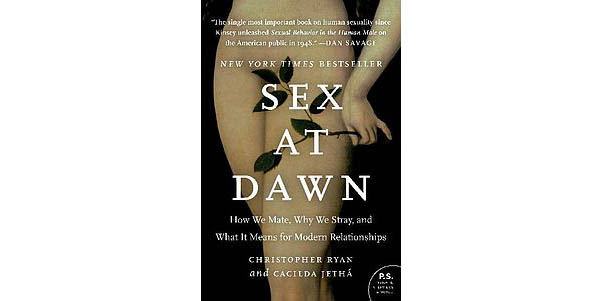A book on how we stray, why we stray and what it means
 CREDIT: HARPERCOLLINS
CREDIT: HARPERCOLLINSSex at Dawn is a book that explores if monogamy is truly the natural human way.
A great and a rare example of truly intriguing popular-science book, Sex at Dawn (2010) may be considered one of the most comprehensive studies on human sexuality of recent times. Utilizing his PhD in anthropology, author Christopher Ryan collaborated with his wife Cacilda Jetha to produce a book that was on the list of top best sellers in its year of publication.
The main idea, which made Sex at Dawn so contradictive and thus popular among the general public as well as among the scholars, lay in an attempt to oppose the so called “standard narrative” of human sexual evolution with a presupposition made by the authors.
If we omit all the details, this book is all about the answer to one question: are we monogamous or polygamous creatures by nature, and how does it reflect in our everyday life?
The Darwinian “standard narrative” of human sexual evolution states that our ancestors’ intimate relationships between males and females resembled sort of a trade. Women traded their sexual fidelity for the resources and defense provided by men, who in turn had to make sure that children of these women belonged to them. Monogamy was eventually the most appropriate way of organization of such societies and seemed to be a fair trade. Ryan and Jetha didn’t easily agree with this; they believed there was more to the story.
If we appeal to the world of our close animal relatives, apes, we’ll find out that such a pattern works only for the harem species like gorillas and chimpanzees. There are also examples of a totally different state of affairs.
Ryan and Jetha provide evidence for the idea that monogamy in our society came to life only with the advent of agriculture around 10,000 years ago. And whether we agree with that or not, this point of view can make us think about the nature of the institution of marriage.
Ask yourself what is the practical reason for the eternal union of two people if they don’t have anything to keep for themselves?
In the pre-agricultural society we obviously had almost no private property and children of more powerful families were being raised, supposedly, in nearly the same conditions as the children of different social classes. So it wasn’t as big of a deal who belonged to whom before the whole institution of marriage arose within the settlement of people.
The aptitude to think of our ancestors through a prism of modern interpersonal relationships was called by the authors of the book “flintstonization”, insinuating that we should not consider them that similar to us because of the different life conditions they lived in.
Ryan and Jetha simply made several references of the isolated groups of people whose beliefs on sexuality can oppose our entire conception of monogamy and polygamy.
People from one African tribe near the Amazon River are convinced the fetus inside a woman’s womb is being made just from the accumulated semen of all the men she had sex with. So when a female wants her child to be neat, strong and good-looking, she finds different men who meet those criteria.
Another unique tradition discussed in the book is that of the Mosuo tribe in the mountains of Southwestern China. When a Mosuo girl turns 14, her parents build a so called “flowering room” for her inside their house, in which she is able to have sex with anybody she wants. If and when she becomes pregnant, her child becomes a member of the family, rather than solely her child. This is how these people have been living for hundreds of years.
There are a lot of opinions and critical articles about this book on the Internet, but Sex at Dawn can be seen as a great source of information on not only human sexuality, but also about what exact position we occupy in this tremendously huge and diverse biological world. This book not only provides a different outlook on sexuality for people living in the western society, it also allows readers to discover more about the isolated tribes of Africa and South America.
If you are interested in expanding your horizons regarding your understanding of human sexuality, then this book is for you.














